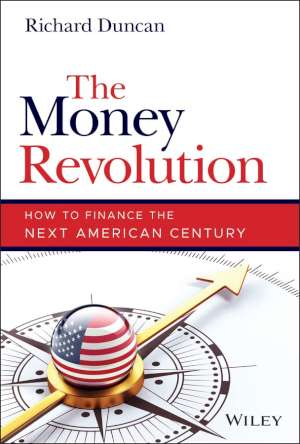26 April 2023
The Money Revolution
How to Finance the Next American Century
Richard Duncan
2022, John Wiley, 493 pages,
ISBN 9781119856276
Reviewer: Maximilian Magnacca

In short, this book is an interesting read that provides a lot of discussion and fascinating history on the first half of the title depicting the changing nature of money and the role of money creation since the establishment of the Federal Reserve in 1913. There is significantly less discussion on the title’s second half about how to finance the next American century. The book can be a bit technical at times, reducing its readability. Still, I have enjoyed this book more than I have struggled with it. The book helps place the Federal Reserve’s and, more generally, central banks’ actions and consequences into context. The author puts out an optimistic and interesting argument for how the US can increase investment, but not one that is completely convincing that there won’t be any significant trade-offs to be made.
The book is split into three sections: Money, Credit, and the Future. The reader can view the first two sections of Money and Credit as one super-section that provides a thorough and somewhat technical history of the Federal Reserve and Money Creation in the US from its foundation to just after the covid-19 pandemic. The author provides a helpful review of the various actions that the Federal Reserve can take and has taken to create money and, subsequently, or equivalently, credit in the economy. This comes through analysing the Federal Reserve’s balance sheet throughout its history.
It is evident from the book that the author comes from a financial markets background as he is quick to highlight the impacts the various tools at the Fed’s disposal have on liquidity and solvency in the banking system, but also subsequently on asset prices, particularly in the context of the quantitative easing measures conducted in the aftermath of the Great Financial Crisis.
There are a few main lessons I have drawn out from the first two sections of the book that are important to highlight.
First, While the author does draw out the point that the Federal Reserve we know today has shifted dramatically from the vision potentially held by those who were around at the time of its establishment that it is not a bad thing. The Federal Reserve has acted in ways that ultimately have supported the economy and all its participants. This is most evident in the shift from an asset-backed currency naturally holding back credit creation, not something the Federal Reserve could have changed or influenced, as well as the gradual reduction in the Required Reserve Ratio, loosening the ability for credit creation continuously.
Second, it is precisely this credit creation that the author aims to highlight and how the US economy, and ultimately the global economy, shifted from capitalism towards a system the author has titled ‘creditism’, where credit and credit growth have supplemented capitalism to become the method for economic growth in the US, and globally, which leads to a wealth effect spurring on increased consumption and investment to an extent. The author speaks positively of this development, stating that without this credit growth, the world economy would have grown much less than it did. An example of this would have been the Reagan era, which was post-Bretton Woods, and creditism was in full effect leading to a boom in people’s wealth through asset price increases and encouraging increased consumption and investment.
Focusing on the book’s final section “Future” the crux of the author’s argument comes into clear view. American credit is monetisable via the Federal Reserve and is still desirable by global finance. It would be wrong for the American government not to take advantage of this opportunity to finance increased investment in research & development that would lead to American and global economic growth and technological innovations.
The author sets out to knock down the two main arguments against his proposal: that an increased debt-to-GDP ratio would be bad, and that government financing of this type would spur inflation.
Beginning with the first argument, when discussing how global markets and investors would perceive the increased debt level, the author references Japan at its >200% debt-to-GDP and highlights how nothing terrible has occurred there. While I don’t find the argument completely convincing due to the difference between the Japanese economy relative to the US economy, the author can make the point stand. It is in the second argument where the book falls short. The latest data available at the time of book writing was from June 2021, and inflation was only beginning to upswing, and pundits were calling it “transitory”. The author agreed with that view at the time of writing. At the time of this review in April 2023, we know with hindsight that inflation has stayed above target significantly. There is an argument to be made that the above-target inflation has been indirectly caused by the vast amounts of stimulus spending on top of some of the other shocks that have occurred in the global economy (the war in Ukraine being one).
I am still on the fence regarding the author’s arguments that a massive investment programme would only bring benefits and no downsides. Despite this, the book was enjoyable, with interesting arguments and a thorough explanation of central bank actions and their history.
